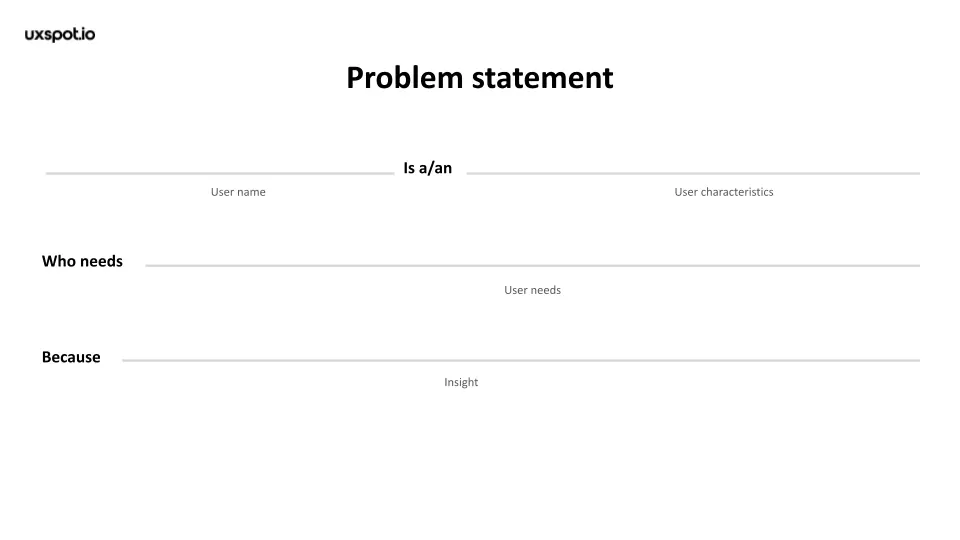Create a problem statement

To start defining the design problem, we need to summarize everything you know in the empathy phase, including pain points, personas, user stories, and user journeys.
A problem statement is a clear description of the user's needs to be addressed.
The problem statement tells the team what user problem to focus on and gives everyone a clear goal. A strong problem statement is focused on people. It should be broad enough to allow some creative freedom, but narrow enough that it can actually be solved by a design solution. Problem statements can be formulated with a simple formula.
Start with the name of the user
Include a brief description of the user's characteristics. Clearly describe the user's need and explain why the user has that need; in other words, provide insight into who the user is.
Problem statements help us set goals. An effective problem statement tells you what the user really needs. By defining the goal clearly and concisely, it gets all members of the design team involved and focused on the same thing.
Problem statements help us understand constraints. We want to know what's keeping users from getting their needs met.
Problem statements help us define what needs to be done. When we finally solve the problem, what will we have to show for it? It is helpful to know what our solution will produce.
Problem statements help us set benchmarks for success. How will we know that we are successful?
Get Canvas-
keywords
- #SetGoals
- #UnderstandConstraints
- #Define
- #Success
Define a problem statement
Identifying the problems users face is one of the most important parts of UX design.
But as important as research is to the UX design process, part of your work will still require some "mind reading" about the user experience. This may seem like a contradiction to the rule of never making assumptions, but sometimes users just do not feel comfortable or know exactly how to express their problem and its implications.
The connection between pain points and problem statements
As a reminder, pain points are any UX problem or friction that frustrates the user and prevents them from getting what they need. Minimizing pain points keeps users happy and encourages them to continue interacting with the product. So how do UX designers find and define pain points?
You need to be sure you know enough about the user to write a problem statement. Problem statements provide a clear description of the user's needs that should be addressed. To create a problem statement, you can use the 5 Ws.
-
keywords
- #SetGoals
- #UnderstandConstraints
- #Define
- #Success
The 5 Ws and H: who, what, when, where, why, and how
The most commonly used framework for creating problem representations is the 5-Ws-and-Hs framework. After defining the user's pain points, you can answer the who, what, when, where, why, and how to solve the user's problem.
Who is affected by the problem? Knowing your users and their background is key to developing successful solutions for them.
What are the problems you are trying to solve? If you identify a user's pain points early on, you can answer the rest of the questions and clarify the context of the pain points.
When does the problem occur? Maybe it occurs right after the end of a long and tedious process, or it's something that happens every day. If you know when the problem occurs, you can better empathize with the user's feelings.
Where is the user when they use the product? The user's physical context is important to your design.
Why is the problem important? If you know how the problem affects the user's experience and life, you can better assess the potential consequences.
How do users achieve their goals by using the product? Understanding how users achieve their goals will help you map the path they take through your product.
To design a solution that meets your users' needs, you need to understand the problem from their perspective. Thinking about the 5 Ws and the How forces you to describe the user persona and map out the entire context of the problem from the user's perspective.
-
keywords
- #SetGoals
- #UnderstandConstraints
- #Define
- #Success
The formula and it's impact
Problem statements provide clarity about your users' goals and help UX designers identify constraints that prevent users from achieving those goals.
Problem statements also help your team measure success. If you assume that the user will be most engaged with your app, you should design the app to be clear and easy for them to understand.
The secret is to put yourself in the user's shoes as much as possible to create a product they'll enjoy interacting with.